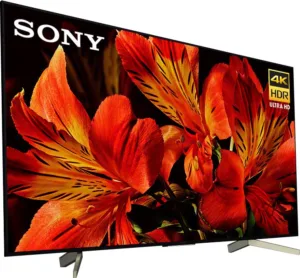Recent trends in large flat screen displays have me wondering if we are seeing the beginning of the end for home theater front projection. (We are already seeing pressure on front projection for commercial markets, but that’s a topic for another time.)

Earlier this month, both Samsung and LG announced they would release 80″-class 8K displays for the home. For Samsung, it’s an 85″ 8K LCD with quantum dot backlights for supporting high dynamic range, while LG moves forward with an 88″ 8K OLED, also HDR-compatible but not nearly as bright as the Samsung offering.
Wait – what? 8K TVs for the home!?!? you’re probably thinking. Yep, 8K is here, and wow, did it arrive in a hurry! That’s because the Chinese manufacturers have basically collapsed pricing in the Ultra HDTV market over just three short years. You’d be nuts NOT to buy a new Ultra HDTV with prices this low, as some models can be had with HDR support for just $9 per diagonal inch.
We already have an abundance of 80″-class Ultra HD flat screen displays and their prices are quite reasonable. A quick check of the Best Buy Web site shows Sony’s XBR85X850F for $3,999. It’s an 85″ LCD with HDR and “smart” connectivity. The same page listed a Samsung QN82Q6FNAFXZA (82 inches, QLED) for $3,499 and Samsung’s UN82NU8000FXZA (82 inches, HDR, QLED) for $2,999.
Got a few more bucks in your pocket? For $19,999, you can have the new Samsung QN85Q900RAFXZA, a top-of-the-line Ultra HD QLED TV. For $14,999, you can pick up LG’s OLED77W8PUA 77″ OLED (not quite 80″es, but close enough). (And for you cheapskates, there were several Ultra HDTVs in the 75″ class for less than $2,500.)
If you currently have a home theater, chances are the projection screen is in the range of 80 to 90 inches. Just two years ago, replacing that setup with a flat screen LCD would have been quite an expensive proposition. But today, you can purchase one of those 80+ inch beauties for less than what a 50″ Pioneer Elite plasma would have cost ten years ago. (And 50 inches seems pretty small now, doesn’t it?)
When I last upgraded my home theater (which was around 2006-2007), I replaced a Sony CRT projector with a Mitsubishi HC5000 (later an HC 6000). That was a Full HD 3LCD model with beautiful color management. I’ve thought about upgrading it over the years even though I hardly use the theater anymore. But looking at these prices, I’d probably be better off just removing the projector and screen and moving to a one-piece flat screen setup.
There are a bunch of reasons why that would be a good idea. For one thing, I have a few older home theater projectors left in my studio and all of them use short-arc lamps that contain metal halides of mercury. If I was to upgrade to a new projector, it would have to use an LED illumination system – and those with 4K resolution are still more expensive than flat screen TVs.
Second, I could get rid of my 92″ projection screen and hang some more art on the wall. (It previously replaced an 82″ screen, and frankly, that was large enough for the room.) I could also eliminate a ceiling power and AC connection and a bunch of wiring from my AV receiver. All of that stuff would be consolidated in a small space under the new TV. (Who knows? I might even go ‘commando’ and just use a soundbar/subwoofer combination!)
I’m sure I’m not the only person who (a) built a home theater in the late 1990s, (b) upgraded the main family room/living room TV to a large, cheap flat screen a decade later, and (c) now spends more time watching that family/living room TV than using the home theater. Mitsubishi exited the projector business almost eight years ago, so I’d never be able to get my 6000 fixed. (But I hardly use it anyway, so who cares?)
Even a 75″ TV would work, and there are plenty of those available at bargain-basement prices. Hisense showed an HDR Ultra HD model (75EU8070) for just a hair over $1,000 and Vizio’s E75-E3 will set you back only $300 more. For those prices, you can hardly go wrong – if you don’t like it a year from now, just recycle it and buy a new one (for less money).
There’s a parallel trend in movie theaters, where the first fine-pitch LED displays are making tentative steps toward replacing high-powered projectors. Pacific Theaters Winnetka in Chatsworth, California installed a 34×17 Samsung fine-pitch LED screen last year and claims it can hit higher levels of peak brightness (3,000 – 4,000 cd/m² shouldn’t be difficult) for true high dynamic range. And of course, LEDs can achieve an enormous color gamut and very deep blacks when off, characteristics of emissive displays.
With ongoing developments in LED technology, we’re likely to see more theaters adopt the LED platform – no projection lamp to replace, because there’s no projector to operate. There are issues about aspect ratios and content formatting to resolve, but we figured them out for digital cinema when we turned our backs on motion picture film.
So why not have our home theater work the same way and get rid of the projector? For that matter, it’s possible and even likely within a decade that LCD and OLED TVs will both be replaced by fine-pitch or ‘micro’ LED displays, giving us the same experience as a state-of-the-art theater.
And home theater projectors will wind up curiosities of an earlier age, like Super 8mm and slide projectors…something Grandpa and Grandma used, along with optical disc players…… – Pete Putman
This article first appeared on Pete’s hdtvexpert.com blog and is reproduced with kind permission.
Peter Putman is the president of ROAM Consulting L.L.C., which provides training, marketing communications, and product testing/development services to manufacturers, dealers, and end-users of displays, display interfaces, and related products. He also publishes HDTVexpert.com, a Web blog focused on 21st-century digital TV, display, interfacing, and wireless technologies, and is a regular contributor to industry trade publications including Sound & Communications, TV Technology, and Church Production.

